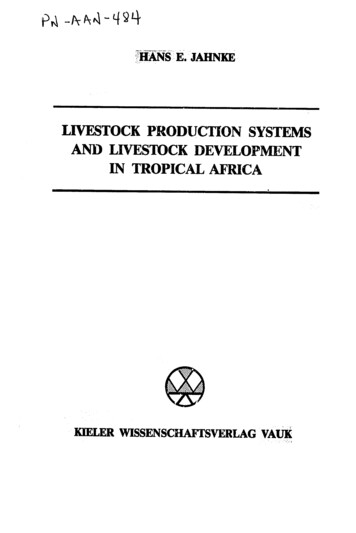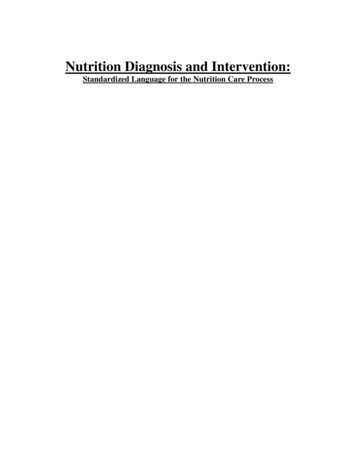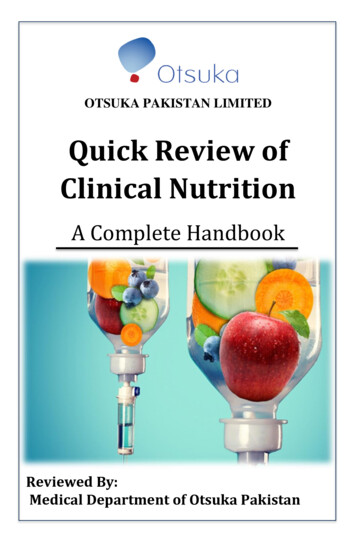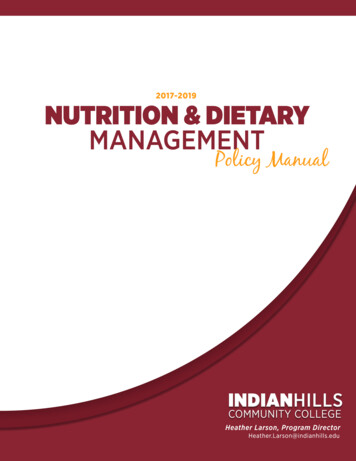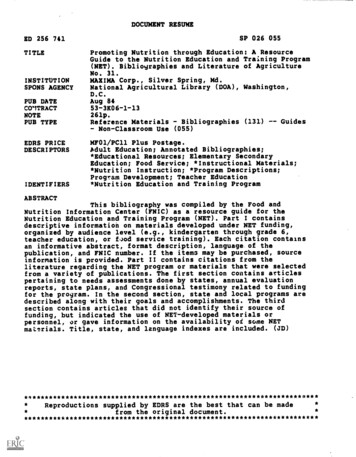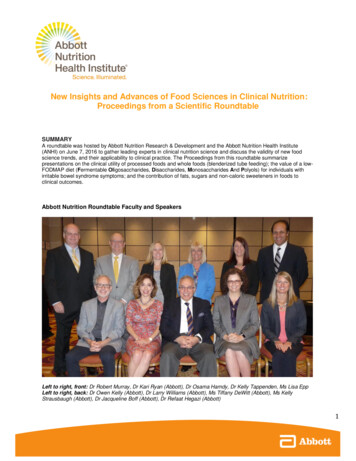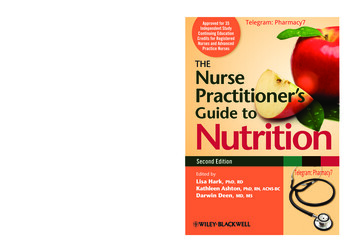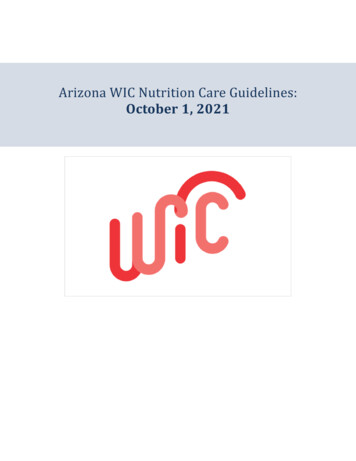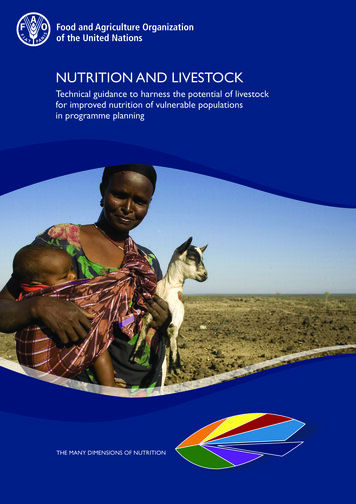
Transcription
NUTRITION AND LIVESTOCKTechnical guidance to harness the potential of livestockfor improved nutrition of vulnerable populationsin programme planningTHE MANY DIMENSIONS OF NUTRITION
NUTRITION AND LIVESTOCKTechnical guidance to harness the potential oflivestock for improved nutrition of vulnerablepopulations in programme planningFood and Agriculture Organization of the United NationsRome, 2020
Required citation:FAO. 2020. Nutrition and livestock– Technical guidance to harness the potential of livestock for improvednutrition of vulnerable populations in programme planning. Rome. https://doi.org/10.4060/ca7348enThe designations employed and the presentation of material in this information product do not imply theexpression of any opinion whatsoever on the part of the Food and Agriculture Organization of the UnitedNations (FAO) concerning the legal or development status of any country, territory, city or area or of itsauthorities, or concerning the delimitation of its frontiers or boundaries. The mention of specific companies orproducts of manufacturers, whether or not these have been patented, does not imply that these have beenendorsed or recommended by FAO in preference to others of a similar nature that are not mentioned.The views expressed in this information product are those of the author(s) and do not necessarily reflect theviews or policies of FAO.ISBN 978-92-5-132053-2 FAO, 2020Some rights reserved. This work is made available under the Creative Commons Attribution-NonCommercialShareAlike 3.0 IGO licence (CC BY-NC-SA 3.0 IGO; igo/legalcode).Under the terms of this licence, this work may be copied, redistributed and adapted for non-commercialpurposes, provided that the work is appropriately cited. In any use of this work, there should be no suggestionthat FAO endorses any specific organization, products or services. The use of the FAO logo is not permitted. Ifthe work is adapted, then it must be licensed under the same or equivalent Creative Commons licence. If atranslation of this work is created, it must include the following disclaimer along with the required citation:“This translation was not created by the Food and Agriculture Organization of the United Nations (FAO). FAOis not responsible for the content or accuracy of this translation. The original [Language] edition shall be theauthoritative edition.”Disputes arising under the licence that cannot be settled amicably will be resolved by mediation and arbitrationas described in Article 8 of the licence except as otherwise provided herein. The applicable mediation rules willbe the mediation rules of the World Intellectual Property Organization http://www.wipo.int/amc/en/mediation/rules and any arbitration will be conducted in accordance with the Arbitration Rules of the United NationsCommission on International Trade Law (UNCITRAL).Third-party materials. Users wishing to reuse material from this work that is attributed to a third party, suchas tables, figures or images, are responsible for determining whether permission is needed for that reuse andfor obtaining permission from the copyright holder. The risk of claims resulting from infringement of any thirdparty-owned component in the work rests solely with the user.Sales, rights and licensing. FAO information products are available on the FAO website(www.fao.org/publications) and can be purchased through publications-sales@fao.org. Requests forcommercial use should be submitted via: www.fao.org/contact-us/licence-request. Queries regarding rightsand licensing should be submitted to: copyright@fao.org.
ContentsForeword.viiAcknowledgements. ixAbbreviations and acronyms. xAbout this paper. xiIntroduction: why technical guidance on livestock and human nutrition?. 1Leveraging livestock for human nutrition. 1What is malnutrition and what are its causes?. 2The potential of animal-source foods for human nutrition. 5Contribution of animal-source foods to nutrition. 5Taboos and cultural factors related to animal-source food intake. 6Impact pathways from livestock to human nutrition. 7Consumption of animal-source foods. 9Crop production. 9Income-generation. 10Women’s empowerment. 11Physical activity. 12Disease transmission. 12Recommendations for making livestock programmes more nutritionsensitive. 15General considerations for programme design. 15Assessing the local nutritional context.15Setting explicit nutrition-related objectives and activities.17Developing a nutrition-sensitive household targeting strategy.18Targeting women for livestock activities.18Understanding the ‘livestock to nutrition’ impact pathways.20Selecting nutrition-related indicators.20Adhering to the ‘do no harm’ principle.20iii
Specific considerations related to livestock production. 21Choice of species.21Seasonal variations in livestock production.22Animal health programmes.23Specific considerations related to the livestock value chains. 24Preservation and processing techniques.24Value-chain analysis.26Business approach.26Use of livestock by-products.27Emergency nutritional programmes.27Nutrition education and behaviour-change communication. 28Promoting the nutritional value of animal-source foods.28Addressing taboos and diversifying consumption of animal-source foods.28Promoting food hygiene and safety at household level.29Broadly targeting nutrition education.30Educating producers and consumers.30Creating an enabling environment for enhanced linkages betweenlivestock and human nutrition. 33References. 35Annex 1: Checklist for nutrition-sensitive livestock interventions. 39Assessment. 39Design. 40Implementation. 40Monitoring and evaluation. 41Annex 2: Resources for further information. 43Specific to livestock. 43Technical documents.43Reviews.44About nutrition-sensitive programming in food and agriculture. 44For designing nutrition-sensitive policy and programmes.44For assessment, monitoring and evaluation of nutrition-sensitive approaches.44For multisectoral planning for nutrition and resilience.45Nutrition education.45iv
Figureþþ Figure 1: Impact pathways from livestock to nutrition. 8Boxesþþ Box 1. Types of malnutrition. 3þþ Box 2. Beliefs, taboos and practices related to consumption ofanimal-source foods. 6þþ Box 3. Promoting family poultry for household food security andnutrition in Tanzania. 16þþ Box 4. Impact of crop and livestock programmes on dietary diversity ofwomen and children in Mali. 17þþ Box 5. Gender focus on livestock-related income-generating activitiesfor better food security and nutrition in Bangladesh. 19þþ Box 6. Improving livestock productivity and milk consumption in acommunity development programme in Nepal. 23þþ Box 7. Traditional preservation and processing techniques foranimal-source foods. 24þþ Box 8. Impact of dairy value chain improvement on food security andnutrition in Rwanda. 26þþ Box 9. Radio soap opera tackles nutrition in pastoral communities inEthiopia. 29þþ Box 10. Behavioural change for improved nutrition through pastoralistfield schools in Ethiopia. 31v
ForewordThe livestock sector plays a crucial role in the social and economic developmentof a country, especially in low- and middle-income countries. It directly supportsthe livelihoods of 600 million poor smallholder farmers in the developing world(Thornton et al., 2006; HLPE, 2016). Livestock are a direct and indirect sourceof food for rural and urban households. It is estimated that livestock-derivedfoods, or animal-source foods (ASF), contribute 18% of global food energyconsumption and 34% of global protein consumption (FAOSTAT, 2016). ASF area unique source of high-quality proteins and bioavailable essential vitaminsand minerals. Livestock are also a powerful safety net for the poor, particularlywomen and pastoralist groups.ASF are an important component of diverse diets, but consumption varieswidely. For example, annual meat consumption ranges from less than 4 kgper person in some countries to more than 100 kg per person, in others. Highconsumption of some ASF is correlated with non- communicable diseases suchas cardiovascular disease and certain types of cancers and contributes to thepublic health burden of disease. However, poor people often consume little orno ASF for various reasons, including poor availability, accessibility (includingprice), dietary patterns that may result from customs, religious taboos and lackof knowledge about their nutritional importance. The high potential of ASF toimprove diets of vulnerable populations makes livestock an important sector fornational policies and development partners’ programmes aiming to improvefood security and nutrition.Leveraging the potential of livestock and optimizing efficiency in productionsystems is now more important than ever before given the current global foodsecurity and nutrition situation. In 2018, the number of chronically undernourished people in the world was estimated to have increased to 821 million (FAO,IFAD, UNICEF, WFP and WHO, 2018). Multiple forms of malnutrition coexist withincountries, households and individuals. The rising prevalence’s of both child undernutrition and adult and child obesity are increasingly evident across manydeveloping countries. Addressing this situation requires integrated, nutrition-sensitive actions across the entire food system. Specific actions are subsequentlyrequired to improve the diets of vulnerable population groups by increasingtheir intake of nutrient-dense foods (including ASF) in order to achieve healthierdiets for all.vii
The Food and Agriculture Organization of the United Nations (FAO), respondingto the mandate to improve diets and raise levels of nutrition enshrined in itsConstitution (FAO, 2017a), works to mainstream nutrition objectives, activitiesand considerations in food and agriculture policies and programmes. Asa knowledge provider, FAO works to equip countries and stakeholders withthe technical capacities and skills needed to develop interventions andprogrammes that improve nutrition outcomes. This technical guidancebrief, Nutrition and Livestock: Technical guidance to harness the potentialof livestock for improved nutrition of vulnerable populations in programmeplanning, has been developed to highlight the role of livestock in nutritionsensitive approaches for vulnerable populations. It emphasizes the linkagesbetween livestock and nutrition that address the nutritional needs of vulnerablehouseholds and groups, with a particular focus on impact pathways, andprovides recommendations for designing and implementing livestock interventions to leverage nutrition outcomes. It captures experiences and adviceof experts from both livestock and nutrition sectors and is based on activitiesdeveloped by the United Kingdom Royal Veterinary College, the InternationalLivestock Research Institute and FAO.Anna LarteyBerhe G. TekolaDirector, Nutrition and FoodSystems Division, FAODirector, Animal Productionand Health Division, FAOviii
AcknowledgementsThis technical guidance brief was developed under the leadership ofPaula Dominguez-Salas (Assistant Professor in Nutrition-Sensitive LivestockAgriculture, joint appointee at the London School of Hygiene and TropicalMedicine, United Kingdom, and the International Livestock Research Institute,Kenya, based at Leverhulme Centre for Integrated Research on Agricultureand Health) and Domitille Kauffmann (Nutrition consultant, Nutrition andFood Systems Division [ESN], FAO, Rome).It was finalized with the support of Deborah Badombena Wanta (Consultant,ESN, FAO, Rome) and Anne Mottet (Livestock development officer, AnimalProduction and Health Division [AGA], FAO, Rome).We are grateful for the contributions from FAO staff across the Organization,and specifically to Philippe Ankers (Strategic Programme 3), Daniela Battaglia(AGA), Ramani Wijesinha Bettoni (ESN), Ruth Charrondiere (ESN), CharlotteDufour (ESN), Jessica Fanzo (ESN) and Doris Rittenschober (ESN). We wouldlike also to acknowledge the contributions of Ahmed ElIdrissi (StrategicProgramme 5), Boitshepo Giyose (ESN), Kazuki Kitaoka (Emergency andRehabilitation Division [TCE]), Emmanuella Olesambu (TCE), Eran Raizman(Animal Health Service), Elvira Uccello (ESN) and Julien Vallet (DPI-AfricaService) and Margaret Wagah (Consultant, ESN) during the review processof the technical guidance brief.The guideline also had the support of Pablo Alarcon and Kristie Smith(Royal Veterinary College, United Kingdom), and of Christophe Breyne (FAOSenegal).The document was edited by Paul Neate. Graphic design and layout serviceswere provided by Davide Cascella. Communication support was providedby Chiara Deligia and Bianca Carlesi (ESN).ix
Abbreviations and acronymsADB: Asian Development BankASF: Animal-source foods (referring to livestock-derived foods in this brief)ESN: Nutrition and Food Systems Division, FAOFAO: Food and Agriculture Organization of the United NationsILP: Intensive livestock productionKAP: Knowledge, attitudes and practicesMDD: Minimum dietary diversityMDD-W: Minimum dietary diversity for womenMIYCN: Maternal, infant and young child nutritionNCD: Non-communicable diseasesND: Newcastle diseaseNSVC: Nutrition-sensitive value chainRVC: Royal Veterinary College, United KingdomSDG: Sustainable Development GoalTCE: Emergency and Rehabilitation Division, FAOVC: Value chainVSF: Vétérinaires Sans FrontièresWFP: World Food Programmex
About this paperThis technical guidance brief summarizes some of the current thinking onhow livestock can address the nutritional needs of vulnerable householdsand groups, with a particular focus on impact pathways. It outlinesrecommendations for designing and implementing livestock interventionsto leverage nutrition outcomes, based on activities developed by the UnitedKingdom Royal Veterinary College, the International Livestock ResearchInstitute (ILRI) and the Food and Agriculture Organization of the UnitedNations (FAO) and a paper compiling the experiences and advice ofexperts from both the livestock and nutrition sectors.It is intended for use by programme planners and managers workingfor government, humanitarian and development agencies involved indesigning and implementing livestock-related policies and programmes,with the objective of helping in integration of nutrition outcomes in theirwork. Additionally, it is aimed at those involved in developing nutritionalpolices and strategies, to take into consideration the potential of livestockbased strategies to improve nutrition.It provides guidance and recommendations relevant to a diversity of contexts(e.g. emergency, resilience, long-term investments), ecosystems (e.g. arid,semi-arid, humid tropics) and production systems (e.g. pastoralism, intensivefarming, mixed farming) and highlights when specific aspects need to beconsidered depending on the context.xi
INTRODUCTION: WHY TECHNICAL GUIDANCE ONLIVESTOCK AND HUMAN NUTRITION?Leveraging livestock for human nutritionGlobally, the demand for animal source foods (ASF) is on the increase andthe contribution for improved nutritional outcomes is enormous. ASF are goodsources of high-quality and bioavailable proteins and essential micronutrientssuch as iron, zinc and vitamins A and B12 (folate). Their consumption canimprove diet quality, hence contributing to balanced and healthy diets. Theyare particularly relevant for nutritionally vulnerable population groups whosediet quality and protein intake are sub-optimal and where ASF consumption islow or negligible (Randolph et al., 2007; Gibson, 2011).Livestock are a key resource for economic growth in many countries, both atnational and household level. Animals are important assets and an essentialsource of income for livestock-keeping households. Moreover, livestock canalso significantly influence the livelihoods of other households that do nothave livestock, as well as supplying inputs for crop production such as fertilizeror animal traction.At the same time, livestock production has been implicated in climate changethrough greenhouse gas emissions and land and water depletion, and inthreats to human health associated with zoonotic and food-borne diseasesand an increase in antimicrobial resistance caused by inappropriate andoveruse of antimicrobials in livestock production. Overconsumption of ASFsuch as red meat and processed meat has been correlated with increasedrisk of some cancers and non-communicable diseases. Therefore, livestockdevelopment efforts should be based on nutrition-sensitive approaches thatconsider dietary gaps and promote consumption of ASF in moderation, in linewith identified nutritional needs and in accordance with available food-baseddietary guidelines. It should also take into account the possible health andenvironmental risks.THE MANY DIMENSIONS OF NUTRITION1
NUTRITION AND LIVESTOCKWell-managed and utilized livestock can play an important role in achievingthe Sustainable Development Goals (SDGs), including poverty eradication(SDG1), promoting food and nutrition security through sustainable agriculturalproduction (SDG2), ensuring healthy lives and well-being (SDG3), achievinggender equality and empowering women (SDG5), encouraging sustainableproduction and consumption practices (SDG12) and combatting climatechange (SDG13) (FAO, 2016a).Appropriately designed livestock interventions can positively impact thenutritional status of vulnerable groups and households through increasedconsumption of nutritious animal-source products, as well as throughseveral other indirect pathways.What is malnutrition and what are its causes?Malnutrition is the abnormal physiological condition caused by deficiencies,excesses or imbalances in intakes of macronutrients (protein, carbohydratesand fats) and/or micronutrients (vitamins and minerals) necessary for anactive and healthy life. Malnutrition includes undernutrition, micronutrientdeficiencies, overweight and obesity. These conditions can arise separately orcoexist (see Box 1). Disease can also lead to malnutrition by reducing appetiteand hence the intake of nutrients, as well as by reducing the body’s ability toabsorb nutrients (e.g. diarrhoea). Malnutrition, in turn, increases susceptibilityto disease because it compromises the body’s immune defences.2
INTRODUCTION: WHY TECHNICAL GUIDANCE ON LIVESTOCK AND HUMAN NUTRITION?þþ Box 1. Types of malnutritionThe following are the main types of malnutrition: Wasting (or ‘acute malnutrition’) is a form of undernutrition that indicates inmost cases recent and severe weight loss, which is often associated with acutestarvation and/or severe disease. Children under five years of age are the mostexposed to risks of acute malnutrition, in particular when transitioning from exclusivebreastfeeding to complementary feeding. A child is described as ‘wasted’ whenits weight in relation to its height is much lower than it should be. The occurrenceof wasting often varies seasonally or increases following natural disasters such asdroughts or floods. Stunting (or ‘chronic malnutrition’) is a form of growth failure that causes bothphysical and cognitive delays in growth and development. It arises when thebody does not absorb sufficient amounts of nutrients over a prolonged period.This can be the result of lack of access to adequate foods and/or disease. A childis described as ‘stunted’ when its height in relation to its age is much less thanit should be. Stunted children also have elevated risk of death, as well cognitivedeficits. Micronutrient deficiency (or ‘hidden hunger’) refers to lack of vitamins, mineralsand/or trace elements that are essential for the proper functioning, growthand metabolism of a living organism. Usually caused by poor diets, it is oftenreferred to as ’hidden hunger’ because its physical symptoms are not obvious,while its consequences can be devastating. It can, and often does, coexist withundernutrition, overweight and obesity. Overweight and obesity refer to a body weight that is above normal for heightas a result of excessive accumulation of fat. These conditions result mainly froman excess of energy consumed relative to energy expended. Both conditionsincrease the risk of non-communicable diseases.Source: WHO (2017)Different forms of malnutrition can coexist in the same community, householdand even in the same individual. For example, stunting is associated withmultiple micronutrient deficiencies; stunted children have increased riskof adult obesity; an obese individual can be anaemic and have othermicronutrient deficiencies. Additionally, pregnant women who are themselvesundernourished are likely to give birth to babies of low birthweight andultimately have children with stunted growth and development, creating anintergenerational cycle of malnutrition.THE MANY DIMENSIONS OF NUTRITION3
NUTRITION AND LIVESTOCKThere are numerous factors that increase vulnerability to malnutrition, includingphysiological and socio-economic factors. These predispose householdsand individuals to food and nutrition insecurity. For example, within a singlehousehold, family members have different nutritional needs: pregnant andlactating women, children under five years of age, adolescent girls, and elderlyand sick people are the most nutritionally vulnerable and require specificnutritional attention. Malnutrition experienced during the first 1 000 days oflife (between conception and the child’s second birthday) has the greatestadverse long-term effects on the individual’s health, educational achievementand earning potentials. In addition, a growing body of evidence points to theneed to pay more attention to adolescent girls’ nutritional needs. Therefore,adopting a life-cycle approach to nutrition is essential.Malnutrition has consequences both for the individual (in terms of both healthand physical and mental growth and development) and for society as awhole (in terms of expenditure on health, impaired cognitive achievementand reduced economic activity).4
THE POTENTIAL OF ANIMAL-SOURCE FOODS FORHUMAN NUTRITIONContribution of animal-source foods to nutritionThe generic term ‘animal-source foods’ (ASF) refers to all foods of animal origin,including fish and wild animals (game/bush meat). However, this brief focusesonly on products derived from farm mammals (cattle, buffalo, camels, sheep,goats, pigs and poultry).Dietary diversity indicators1 are commonly used to provide information aboutdiet quality and its nutritional adequacy. Among the 7–12 food groups thatare commonly considered (the total number of food groups depends on theindicator), three or four are ASF: dairy products, eggs, meat and/or organ meat.This preponderance of ASF groups reflects the great nutritional value of thesefood products, which provide highly bioavailable nutrients that are essentialfor growth and health and that may be difficult to obtain from plant-sourcefoods alone (Murphy and Allen, 2003).ASF are energy-dense foods. They are a good source of high-quality proteins:the proteins they contain are highly digestible and have a good profile ofessential amino acids. For example, ASF generally contain high concentrationsof threonine, lysine and sulphur-containing amino acids, which are in relativelyshort supply in most plant-based foods. They are also a good source of severalcritical micronutrients, such as iron, zinc and vitamins A and B12 that are oftenlacking in the diets of nutritionally vulnerable populations. The bioavailability ofthese micronutrients is also higher in ASF than in many plant-derived foods. Forexample, red meat and offal (such as liver) contain high levels of haem ironand provide it in an easily absorbable form. Livestock-derived foods are alsorelatively rich in lipids, particularly saturated fatty acids and cholesterol. Theseare important components of a balanced diet but have been linked withmany health concerns including increased incidence of non-communicablediseases (NCDs) when consumed in excess of dietary needs.Including Household Dietary Diversity Score, Minimum Dietary Diversity-Women, Individual DietaryDiversity Scores and Minimum Acceptable Diet (see FAO (2016b)).1THE MANY DIMENSIONS OF NUTRITION5
NUTRITION AND LIVESTOCKThe good amino acids profile and high micronutrient density andbioavailability make ASF very efficient for improving the quality of diets,especially during periods of high nutritional demand such as pregnancy,lactation, early infancy and childhood, and adolescence (Iannotti, Barronand Roy, 2008). Relatively small amounts of ASF can substantially increasethe nutrient adequacy of the diet.It should also be noted that about two-thirds of the world’s adult populationdo not produce the enzyme lactase, which is needed to digest lactose, thesugar found in milk and other dairy products to a lesser extent. While lactoseintolerance can create symptoms such as bloating and diarrhea, consumptionof dairy products is increasing in regions with lactase deficiency due to colonmicrobiome adaptation (Forsgård, 2019) and lower lactose contents inproducts such as cheese and yogurts.Taboos and cultural factors related to animal-sourcefood intakeNumerous cultural and religious beliefs and taboos influence consumptionof ASF, including restrictions on which ASF can be eaten or by whom. Womenand children, in particular, are often subject to such restrictions. Meat is morelikely to be subject to food taboos than any
This technical guidance brief was developed under the leadership of Paula Dominguez-Salas (Assistant Professor in Nutrition-Sensitive Livestock Agriculture, joint appointee at the London School of Hygiene and Tropical Medicine, United Kingdom, and the International Livestock Research Institute,


